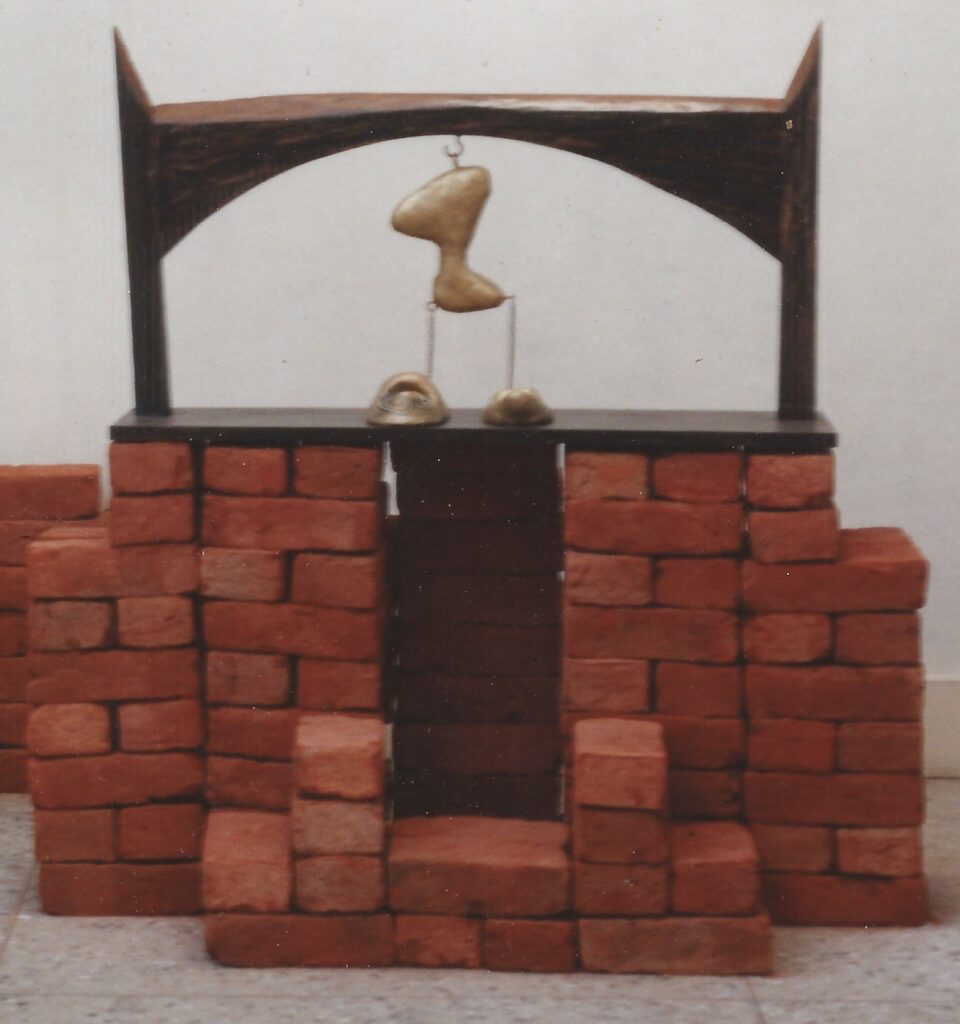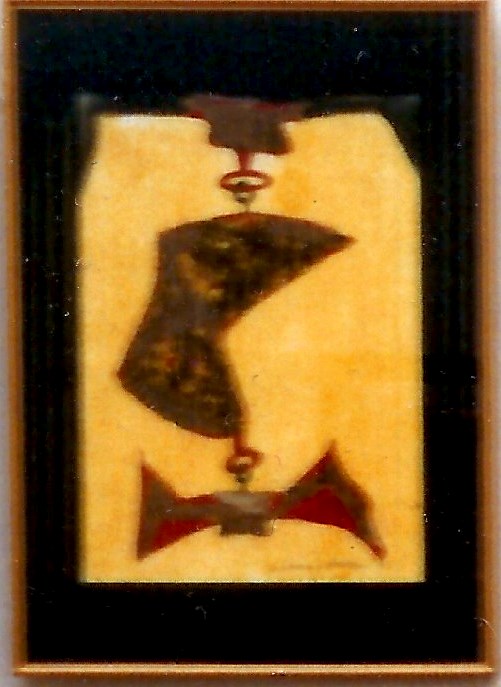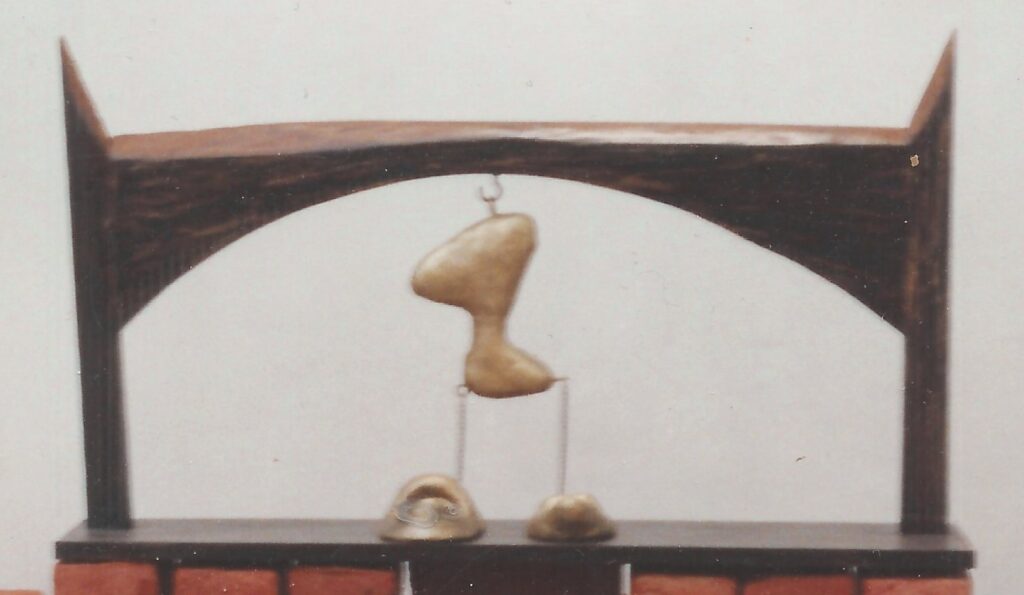The X factor of Installation Art/Archana Hebbar Colquhoun
Installation Art
I would like to quote from the Tate glossary of art terms a definition of Installation Art.
“Mixed-media constructions or assemblages usually designed for a specific place and for a temporary period of time”
This definition is broad, succinct and most suitably describes many of my installation works. One example is the Altar, an installation work in which I bring together paintings, sculptural works in wood and brass, bricks, and a temple bell that I displayed at a gallery in New Delhi, as a single work.

However, the presentation features of an art installation allow an artist to mix and match artworks and objects and present what might be a hybrid collection of works as one homogenous whole. The arrangement and display of the works and objects are designed by the artist (not by a curator) and the completed assemblage would result in a new, composite work – an art installation bearing the name of the artist as its creator.
Installation art throws up rich and exciting possibilities for artistic expression.
I would like to present a descriptive analysis of the installation work titled Altar. The installation consists of four discrete components: the centrepiece; the pedestal; the paintings; and a temple bell.
The Centrepiece – a Torii gateway with Obstacles
The main component of the installation, the centrepiece, is a Torii gateway with chained objects suspended from the top-centre of the gateway; the objects acting as an obstacle to entry.
The main advantage of installation art is that an artist can create multiple works of “installation” using the same set of (art) objects by assembling them in different compositions and playing around with the placements of the objects. The possibilities for innovation are virtually limitless. The centrepiece of the present installation consists of four detachable pieces: the Torii gateway and three small brass sculptures, connected by chains – acting as an obstacle.
The obstacle consists of one main part – a Z-shaped form and an auxiliary part – two forms resting on the base of the Torii gateway connected on either side by a chain to the suspended Z-shaped form. The two forms (not clearly seen in the featured photograph) are sculptural expressions of a slipper and a footprint in 3D form. The three forms (of a hand-held size) are in fact three independent sculptural works, which can be displayed individually or in combination with other related works.
[Note: I made a series of small sculptural works, cast in brass, all of which can be connected to one or more works, interchangeably, using chains. A discussion about these works would form the subject of a separate article.]
The Pedestal
The centrepiece, the Torii gateway, rests on a dry wall of bricks, within which is a niche acting as the sanctum sanctorum of a temple with an architectural feature of a step leading into the small, vertical hollow in the wall.

Sculptural works, unless very large, are always placed on a pedestal in a gallery setting. The use of a brick construction instead of a wooden pedestal box to display the Torii sculpture opens up the meaning of the work (consisting of the Torii and the brick wall) since the pedestal becomes a part of the work. The brick wall, on which the Torii gateway is placed, can be seen as depicting sacred architecture that has a sculptural component, the Torii. If the Torii was placed on a wooden display pedestal instead of a brick wall it would be seen as a (simple*) work of sculpture.
The brick wall plays a transformative role in terms of meaning and construction within the installation.
* I use the term “simple” not as a qualitative description of the art of sculpture but as a depth of vision employed in reading a work of art.
[Note: The bricks used in this installation are common burnt clay bricks made and used in India for constructing houses and other small buildings. The bricks are backing bricks (as opposed to facing bricks – used as a veneer) and they require rendering with mortar to hold them in place and need plastering once a wall is built.
The dry brick wall on which the centrepiece of the present installation rests can easily be taken down without damaging the bricks and the bricks put to use for which they were made originally. The bricks in the dry wall in the installation do not sit flush on and against each other as no mortar is used to build the wall.
Paintings of Torii gateways with Obstacles
I explored further the subject of the main (sculptural) component of the (Torii gateway) installation in paintings. The two paintings hanging on the wall, above the centrepiece, one to the left are from a series of paintings the idea for which came to me after I had done a body of Torii sculptural works. The paintings are of a slightly later date.

The main subject of the paintings is the two-part form of an “obstacle.” Although the form of the Torii no longer appears in the paintings the top edge of the painting is suggestive of the existence of a Torii gateway.
The paintings are self-explanatory, except that they are titled “Herbal Paintings” – an entirely new category of works. As I continued to explore the theme of the “Torii with obstacles” in a 2D medium the principal focus of the works shifted to the pigments I chose to use in making the paintings. The subject matter of a Torii with obstacles that was the source of the paintings became incidental to the painted works, a mere vestige of an earlier idea.
The pigments used in the paintings are turmeric, kumkum, henna, and kaajal (organic eyeliner paste).
[Note: Turmeric and the red kumkum powder are indispensable to any ritual performed in a temple, and are considered sacred.]
A Bronze Temple Bell
The presence of the temple bell in the installation not only points to another series of works titled “Sound Sculptures” but also transforms the meaning of the installation, just as the brick wall does.
Many of the small sculptural works described earlier in the essay (the obstacles in the Torii) are in fact examples of sound sculptures. When the original clay or plaster forms of the sculptural works were cast in brass I asked the artisan to place a tiny stone inside the hollow of the brass works so as to create a sound (as does a child’s rattle) when the object is picked up by a viewer for closer inspection.
The fact that these brass works incorporate the element of sound is not evident unless a viewer is already familiar with the works. The bell acts as a connecting thread to the sound element hidden in the brass sculptures.
The (hybrid) collection of works featured in the installation present a meaning that is concentric.
The temple bell with its definitive meaning provides a trajectory through which the viewer comes to see the installation as one that represents sacred space.
The temple bell and the bricks are two components of the installation that are obviously not made by me. This is one advantage of installation art where works and objects not made by the artist can be presented in a 3D assemblage along with other works without the artist being accused of misappropriation.
There is no possibility of doubt in the viewer’s mind as to the origin and identity of the temple bell and the utilitarian bricks, both of which are integral to the installation.
Conclusion
The works and objects of one installation can be presented in a different combination in another installation and context. In one installation the same set of objects can be displayed in a grouping that is intended to convey one primary meaning but when presented in a different combination (irrespective of the display space) the installation could express a statement that could not be read from a construction of an earlier installation, which consisted of the exact same set of objects.
For example, if the temple bell was not hung above the centrepiece but placed on the floor, upright or on its side, it would change the meaning of the work, almost entirely.
A number of other issues to be discussed and clarified with respect to this installation arise in my mind, although the essay has now come to its end.
No writing on an artwork can and will be conclusive.
